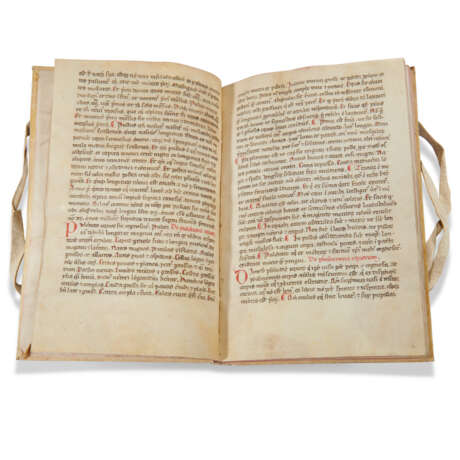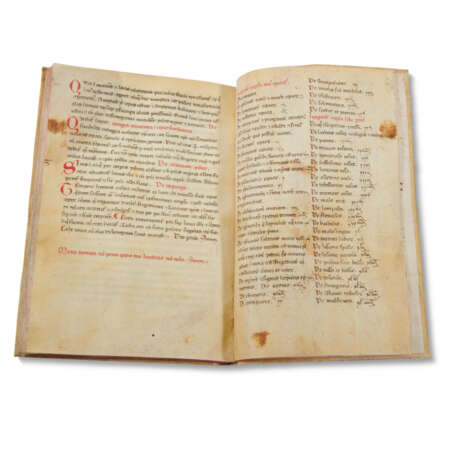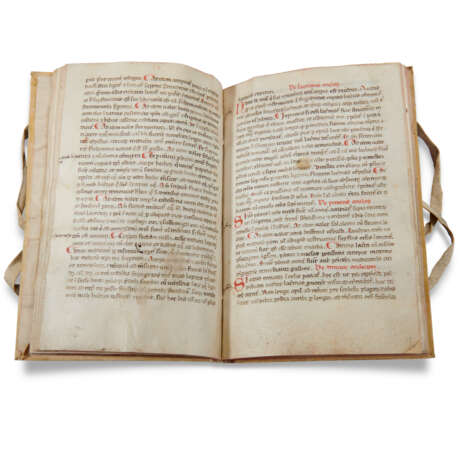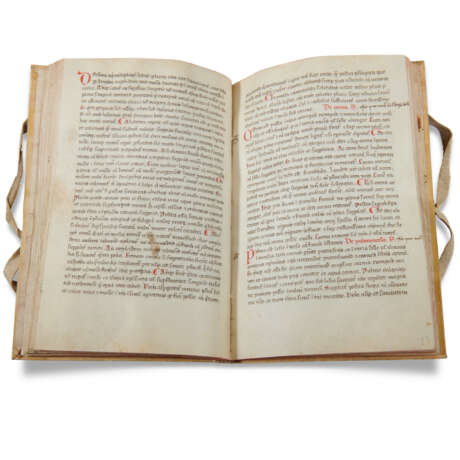ID 794359
Lot 23 | BORGOGNONI, Theodoric, Bishop of Cervia (1205-1296/8)
Estimate value
£ 15 000 – 20 000
Mulomedicina, in Latin, manuscript on vellum [Italy, c.1300]
A rare medieval text on the raising and training of horses, and on hippiatric medicine, compiled by Theodoric Borgognoni, one of the foremost surgeons of the Middle Ages.
210 x 140mm. 40 + i (paper) leaves, complete, collation: 1-58, modern pencil foliation 1-40, 31 lines, ruled space: 160 x 110mm, rubrics and initials in red throughout, capitals touched in red, catchwords survive (opening leaves darkened with some staining and natural flaws to vellum, marginal staining especially at end). Limp vellum binding, vellum ties, manuscript title on spine (slightly cockled).
Provenance:
(1) Biblioteca de D. Francisco Bañares: his bookplate, GB no 244.
(2) Don A. Canovas del Castillo (1828-1897), Spanish politician and historian: his bookplate with coat of arms.
Content: Mulomedicina, incipit: ‘Incipit mulo medicina ex dictis medicor[um] et mulo sapientium compilata a fratre Theodorico ordinis predicator[um] epi[scopo] Cerviensis’; beginning ‘Mulomedicine ap[u]d grecos lati[n]osq[ue] auctores […]’; part one ff.1-13v; part two ff.14-30; part three ff.30-37v; index ff.38-38v; later annotations f.39; blanks ff.39v-40v.
Brogognoni’s treatise is divided into three particulae: the first deals with general hippology – that is the raising, training and aesthetic characteristics of horses; the second and first chapters of the third deal with the treatment of various pathologies (with a particular focus on the eyes); while the final sections of the third part deal with the bad behaviour of horses.
Theodoric Borgognoni, also known as Theodoric of Lucca, Dominican friar, Bishop of Bitonto from 1262 and Bishop of Cervia from 1266 until his death, was one of the foremost surgeons of the Middle Ages. He is widely credited for having introduced basic antiseptic practice and anaesthetics in surgery, and his Chirurgia, a four-volume work covering the major fields of medieval surgery, is one of the most significant contributions to modern western medicine. His status as a hippiatric surgeon is less documented, but his surviving will (Bologna, Archivio di Stato, fondo Conventi Soppressi, San Domenico 77⁄7411,) provides valuable insight into Borgognoni’s experience with horses. In it we discover that Borgognoni died an extremely wealthy man, rich in money, property and horses: ‘denariis et localibus, in argento [et] equis et animalibus et casis et annulis argenti et auri et aliis rebus […]’ and that he received 165 gold florins to cure both Pope Martin IV and his white horse (‘recepit a dom[i]no papa Martino centum sexaginta quinque florenos auri, ex eo quia ipse domnus Theodoricus personaliter ad curiam Romanam ivit causa medicandi dictum papam Martinum de quadam egritudine et unum palafrenum album valde pulchrum’). Unlike the Chirurgia, Borgognoni’s Mulomedicina is not an original work, but rather a compendium of ancient and contemporary sources drawing on, among others, Giordano Ruffo, author of the Mariscalcia equorum and Vegetius, author of the Digesta artis mulomedicinalis. For a recent study on the manuscript tradition of Borgognoni’s Mulomedicina see L. Sannicandro, ‘Sulla tradizione manoscritta della Mulomedicina di Teodorico Borgognoni: problemi di classificazione di alcuni testimoni’, Morborum et signa et causas praedicere curasque monstrare. La medicina veterinaria nel mondo antico e medievale. Atti del V Convegno Internazionale Monaco di Baviera, 29-31 marzo 2017, 2018, pp.213-238.
Only 13 Latin manuscripts of Borgognoni’s Mulomedicina are documented in public institutions, and only four outside of Italy: four are at the Vatican (Biblioteca Apostolica Vaticana, Reg. lat. 1010, ff. 247-297; Reg. Lat. 1269, ff.1-47; Barb. Lat. 327; and Vat. lat. 3189); one in Milan (Biblioteca Ambrosiana B. 91 sup., ff. 79-107); one in Modena (Biblioteca Estense Universitaria, cod. Lat. 637 = Campori a. J.5.18); one in Pavia (Biblioteca Universitaria 72, ff.1-48v); one in Turin (Biblioteca Nazionale 791 [E. VI. 4], ff.1-84); one in Venice (Biblioteca Marciana, lat. app. VII 24 [3472], ff.1-30); one in Paris (Bibliothèque Nationale, nouv. acq. lat. 548); one in Toulouse (Bibliothèque d’Étude et du Patrimoine, 2844, ff.1-35); one in Sankt Florian (Bibliothek des Augustiner Chorherrenstifts XI. 100, ff.221v-241v); and one in Vienna (Österreichische Nationalbibliothek, cod. 2414, ff.1-32v).
Special notice
No VAT on hammer price or buyer's premium.
| Place of origin: | Italy, Europe |
|---|---|
| Auction house category: | Medieval & renaissance manuscripts, Medicine & science |
| Place of origin: | Italy, Europe |
|---|---|
| Auction house category: | Medieval & renaissance manuscripts, Medicine & science |
| Address of auction |
CHRISTIE'S 8 King Street, St. James's SW1Y 6QT London United Kingdom | |
|---|---|---|
| Preview |
| |
| Phone | +44 (0)20 7839 9060 | |
| Buyer Premium | see on Website | |
| Conditions of purchase | Conditions of purchase |






